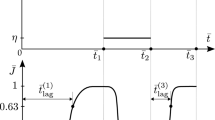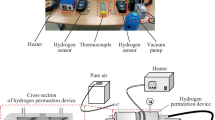Abstract
The electrochemical permeation test is one of the most used methods for characterising hydrogen diffusion in metals. The flux of hydrogen atoms registered in the oxidation cell might be fitted to obtain apparent diffusivities. The magnitude of this coefficient has a decisive influence on the kinetics of fracture or fatigue phenomena assisted by hydrogen and depends largely on hydrogen retention in microstructural traps. In order to improve the numerical fitting of diffusion coefficients, a permeation test has been reproduced using FEM simulations considering two approaches: a continuum 1D model in which the trap density, binding energy and the input lattice concentrations are critical variables and a polycrystalline model where trapping at grain boundaries is simulated explicitly including a segregation factor and a diffusion coefficient different from that of the interior of the grain. Results show that the continuum model captures trapping delay, but it should be modified to model the trapping influence on the steady state flux. Permeation behaviour might be classified according to different regimes depending on deviation from Fickian diffusion. Polycrystalline synthetic permeation shows a strong influence of segregation on output flux magnitude. This approach is able to simulate also the short-circuit diffusion phenomenon. The comparison between different grain sizes and grain boundary thicknesses by means of the fitted apparent diffusivity shows the relationships between the registered flux and the characteristic parameters of traps.



















Similar content being viewed by others
References
Álvarez G, Peral LB, Rodríguez C et al (2019) Hydrogen embrittlement of structural steels: effect of the displacement rate on the fracture toughness of high-pressure hydrogen pre-charged samples. Int J Hydrog Energy 44:15634–15643. https://doi.org/10.1016/J.IJHYDENE.2019.03.279
Ashby MF (1970) The deformation of plastically non-homogeneous materials. Philos Mag A J Theor Exp Appl Phys 21:399–424. https://doi.org/10.1080/14786437008238426
Bechtle S, Kumar M, Somerday BP et al (2009) Grain-boundary engineering markedly reduces susceptibility to intergranular hydrogen embrittlement in metallic materials. Acta Mater 57:4148–4157. https://doi.org/10.1016/J.ACTAMAT.2009.05.012
Bouhattate J, Legrand E, Feaugas X (2011) Computational analysis of geometrical factors affecting experimental data extracted from hydrogen permeation tests: I—consequences of trapping. Int J Hydrog Energy 36:12644–12652. https://doi.org/10.1016/J.IJHYDENE.2011.06.143
Crank J (1979) The mathematics of diffusion. Oxford University Press, Oxford
Dadfarnia M, Sofronis P, Neeraj T (2011) Hydrogen interaction with multiple traps: can it be used to mitigate embrittlement? Int J Hydrog Energy 36:10141–10148. https://doi.org/10.1016/j.ijhydene.2011.05.027
del Busto S, Betegón C, Martínez-Pañeda E (2017) A cohesive zone framework for environmentally assisted fatigue. Eng Fract Mech 185:210–226. https://doi.org/10.1016/J.ENGFRACMECH.2017.05.021
Devanathan MAV, Stachurski Z, Beck W (1963) A technique for the evaluation of hydrogen embrittlement characteristics of electroplating baths. J Electrochem Soc 110:886–890
Díaz A, Alegre JM, Cuesta II (2016a) Coupled hydrogen diffusion simulation using a heat transfer analogy. Int J Mech Sci. https://doi.org/10.1016/j.ijmecsci.2016.07.020
Díaz A, Alegre JM, Cuesta II (2016b) A review on diffusion modelling in hydrogen related failures of metals. Eng Fail Anal. https://doi.org/10.1016/j.engfailanal.2016.05.019
Dietzel W, Pfuff M, Juilfs GG (2006) Hydrogen permeation in plastically deformed steel membranes. Mater Sci 42:78–84. https://doi.org/10.1007/s11003-006-0059-8
Frappart S, Feaugas X, Creus J et al (2010) Study of the hydrogen diffusion and segregation into Fe–C–Mo martensitic HSLA steel using electrochemical permeation test. J Phys Chem Solids 71:1467–1479. https://doi.org/10.1016/J.JPCS.2010.07.017
Frappart S, Feaugas X, Creus J et al (2012) Hydrogen solubility, diffusivity and trapping in a tempered Fe–C–Cr martensitic steel under various mechanical stress states. Mater Sci Eng A 534:384–393. https://doi.org/10.1016/J.MSEA.2011.11.084
Gerberich WW, Marsh PG, Hoehn JW (1996) Hydrogen induced cracking mechanisms–are there critical experiments? Hydrogen effects in materials. Wiley, New York, pp 539–551
Gesnouin C, Hazarabedian A, Bruzzoni P et al (2004) Effect of post-weld heat treatment on the microstructure and hydrogen permeation of 13CrNiMo steels. Corros Sci 46:1633–1647. https://doi.org/10.1016/J.CORSCI.2003.10.006
Hirth J (1980) Effects of hydrogen on the properties of iron and steel. Metall Trans A 11:861–890. https://doi.org/10.1007/BF02654700
Hoch BO (2015) Modelling of hydrogen diffusion in heterogeneous materials: implications of the grain boundary connectivity. Doctoral dissertation, Universite de La Rochelle
Hoch BO, Metsue A, Bouhattate J, Feaugas X (2015) Effects of grain-boundary networks on the macroscopic diffusivity of hydrogen in polycrystalline materials. Comput Mater Sci 97:276–284
ISO 17081:2014 Method of measurement of hydrogen permeation and determination of hydrogen uptake and transport in metals by an electrochemical technique. International Organization for Standardization, 2014. www.iso.org
Jiang DE, Carter EA (2004) Diffusion of interstitial hydrogen into and through bcc Fe from first principles. Phys Rev B 70:64102
Jothi S, Croft TN, Wright L et al (2015) Multi-phase modelling of intergranular hydrogen segregation/trapping for hydrogen embrittlement. Int J Hydrog Energy 40:15105–15123. https://doi.org/10.1016/J.IJHYDENE.2015.08.093
Juilfs G (2002) Das Diffusionsverhalten von Wasserstoff in einem niedriglegierten Stahl unter Berücksichtigung des Verformungsgrades. GRIN Verlag, Munich
Kharin V (2014) Comments on “Computational analysis of geometrical factors affecting experimental data extracted from hydrogen permeation tests: I—consequences of trapping” [Int J Hydrog Energy (2011) 36:2644–12652] and “... II—consequences of trapping and an oxide layer” [Int J Hydrog Energy (2012) 37:13574–13582], “Corrigenda...” to both [Int J Hydrog Energy (2014) 39:2430], and on “... III—comparison with experimental results from the literature” [Int J Hydrog Energy (2014) 39:1145–1155] with “Gene Int J Hydrog Energy 39:19846–19850. https://doi.org/10.1016/J.IJHYDENE.2014.09.032
Koyama M, Rohwerder M, Tasan CC et al (2017a) Recent progress in microstructural hydrogen mapping in steels: quantification, kinetic analysis, and multi-scale characterisation. Mater Sci Technol 33:1481–1496. https://doi.org/10.1080/02670836.2017.1299276
Koyama M, Yamasaki D, Nagashima T et al (2017b) In situ observations of silver-decoration evolution under hydrogen permeation: effects of grain boundary misorientation on hydrogen flux in pure iron. Scr Mater 129:48–51. https://doi.org/10.1016/J.SCRIPTAMAT.2016.10.027
Kumnick AJ, Johnson HH (1980) Deep trapping states for hydrogen in deformed iron. Acta Metall 28:33–39. https://doi.org/10.1016/0001-6160(80)90038-3
Lan L, Kong X, Hu Z et al (2016) Hydrogen permeation behavior in relation to microstructural evolution of low carbon bainitic steel weldments. Corros Sci 112:180–193. https://doi.org/10.1016/J.CORSCI.2016.07.025
Legrand E, Feaugas X, Bouhattate J (2014) Generalized model of desorption kinetics: characterization of hydrogen trapping in a homogeneous membrane. Int J Hydrog Energy 39:8374–8384. https://doi.org/10.1016/J.IJHYDENE.2014.03.191
Liu MA, Rivera-Díaz-del-Castillo PEJ, Barraza-Fierro JI et al (2019) Microstructural influence on hydrogen permeation and trapping in steels. Mater Des 167:107605. https://doi.org/10.1016/J.MATDES.2019.107605
Macadre A, Artamonov M, Matsuoka S, Furtado J (2011) Effects of hydrogen pressure and test frequency on fatigue crack growth properties of Ni–Cr–Mo steel candidate for a storage cylinder of a 70 MPa hydrogen filling station. Eng Fract Mech 78:3196–3211. https://doi.org/10.1016/J.ENGFRACMECH.2011.09.007
Macadre A, Nakada N, Tsuchiyama T, Takaki S (2015) Critical grain size to limit the hydrogen-induced ductility drop in a metastable austenitic steel. Int J Hydrog Energy 40:10697–10703. https://doi.org/10.1016/J.IJHYDENE.2015.06.111
Martin ML, Somerday BP, Ritchie RO et al (2012) Hydrogen-induced intergranular failure in nickel revisited. Acta Mater 60:2739–2745. https://doi.org/10.1016/J.ACTAMAT.2012.01.040
Martínez-Pañeda E, del Busto S, Niordson CF, Betegón C (2016a) Strain gradient plasticity modeling of hydrogen diffusion to the crack tip. Int J Hydrog Energy 41:10265–10274. https://doi.org/10.1016/j.ijhydene.2016.05.014
Martínez-Pañeda E, Niordson CF, Gangloff RP (2016b) Strain gradient plasticity-based modeling of hydrogen environment assisted cracking. Acta Mater 117:321–332. https://doi.org/10.1016/J.ACTAMAT.2016.07.022
Martínez-Pañeda E, Golahmar A, Niordson CF (2018) A phase field formulation for hydrogen assisted cracking. Comput Methods Appl Mech Eng 342:742–761. https://doi.org/10.1016/J.CMA.2018.07.021
McMahon CJ (2001) Hydrogen-induced intergranular fracture of steels. Eng Fract Mech 68:773–788. https://doi.org/10.1016/S0013-7944(00)00124-7
McNabb A, Foster PK (1963) A new analysis of the diffusion of hydrogen in iron and ferritic steels. Trans Metall Soc AIME 227:618–627
Miresmaeili R, Ogino M, Nakagawa T, Kanayama H (2010) A coupled elastoplastic-transient hydrogen diffusion analysis to simulate the onset of necking in tension by using the finite element method. Int J Hydrog Energy 35:1506–1514. https://doi.org/10.1016/j.ijhydene.2009.11.024
Montella C (1999) Discussion on permeation transients in terms of insertion reaction mechanism and kinetics. J Electroanal Chem 465:37–50. https://doi.org/10.1016/S0022-0728(99)00051-0
Nagao A, Smith CD, Dadfarnia M et al (2012) The role of hydrogen in hydrogen embrittlement fracture of lath martensitic steel. Acta Mater 60:5182–5189. https://doi.org/10.1016/J.ACTAMAT.2012.06.040
Novak P, Yuan R, Somerday BP et al (2010) A statistical, physical-based, micro-mechanical model of hydrogen-induced intergranular fracture in steel. J Mech Phys Solids 58:206–226. https://doi.org/10.1016/J.JMPS.2009.10.005
Olden V, Thaulow C, Johnsen R et al (2008) Application of hydrogen influenced cohesive laws in the prediction of hydrogen induced stress cracking in 25%Cr duplex stainless steel. Eng Fract Mech 75:2333–2351. https://doi.org/10.1016/j.engfracmech.2007.09.003
Ono K, Meshii M (1992) Hydrogen detrapping from grain boundaries and dislocations in high purity iron. Acta Metall Mater 40:1357–1364. https://doi.org/10.1016/0956-7151(92)90436-I
Oriani RA (1970) The diffusion and trapping of hydrogen in steel. Acta Metall 18:147–157. https://doi.org/10.1016/0001-6160(70)90078-7
Oudriss A, Creus J, Bouhattate J et al (2012) Grain size and grain-boundary effects on diffusion and trapping of hydrogen in pure nickel. Acta Mater 60:6814–6828. https://doi.org/10.1016/j.actamat.2012.09.004
Park I-J, Lee S, Jeon H, Lee Y-K (2015) The advantage of grain refinement in the hydrogen embrittlement of Fe-18Mn-0.6C twinning-induced plasticity steel. Corros Sci 93:63–69. https://doi.org/10.1016/J.CORSCI.2015.01.012
Raina A, Deshpande VS, Fleck NA (2017) Analysis of electro-permeation of hydrogen in metallic alloys. Philos Trans A Math Phys Eng Sci 375:20160409. https://doi.org/10.1098/rsta.2016.0409
Sofronis P, McMeeking RM (1989) Numerical analysis of hydrogen transport near a blunting crack tip. J Mech Phys Solids 37:317–350. https://doi.org/10.1016/0022-5096(89)90002-1
Sofronis P, Liang Y, Aravas N (2001) Hydrogen induced shear localization of the plastic flow in metals and alloys. Eur J Mech A/Solids 20:857–872. https://doi.org/10.1016/S0997-7538(01)01179-2
Song EJ (2015) Hydrogen desorption in steels. Grad Inst Ferr Technol, 106
Song EJ, Suh D-W, Bhadeshia HKDH (2013) Theory for hydrogen desorption in ferritic steel. Comput Mater Sci 79:36–44. https://doi.org/10.1016/J.COMMATSCI.2013.06.008
Takasawa K, Ikeda R, Ishikawa N, Ishigaki R (2012) Effects of grain size and dislocation density on the susceptibility to high-pressure hydrogen environment embrittlement of high-strength low-alloy steels. Int J Hydrog Energy 37:2669–2675. https://doi.org/10.1016/J.IJHYDENE.2011.10.099
Toribio J, Kharin V (2015) A generalised model of hydrogen diffusion in metals with multiple trap types. Philos Mag. https://doi.org/10.1080/14786435.2015.1079660
Turnbull A (1993) Modelling of environment assisted cracking. Corros Sci 34:921–960. https://doi.org/10.1016/0010-938X(93)90072-O
Turnbull A (2015) Perspectives on hydrogen uptake, diffusion and trapping. Int J Hydrog Energy. https://doi.org/10.1016/j.ijhydene.2015.06.147
Turnbull A, de Santa Saenz, Maria M, Thomas ND (1989) The effect of H2S concentration and pH on hydrogen permeation in AISI 410 stainless steel in 5% NaCl. Corros Sci 29:89–104. https://doi.org/10.1016/0010-938X(89)90082-6
Turnbull A, Ferriss DH, Anzai H (1996) Modelling of the hydrogen distribution at a crack tip. Mater Sci Eng A 206:1–13. https://doi.org/10.1016/0921-5093(95)09897-6
Van den Eeckhout E, Laureys A, Van Ingelgem Y, Verbeken K (2017) Hydrogen permeation through deformed and heat-treated Armco pure iron. Mater Sci Technol 33:1515–1523. https://doi.org/10.1080/02670836.2017.1342015
Vecchi L, Simillion H, Montoya R et al (2018a) Modelling of hydrogen permeation experiments in iron alloys: characterization of the accessible parameters—Part I—the entry side. Electrochim Acta 262:57–65. https://doi.org/10.1016/J.ELECTACTA.2017.12.172
Vecchi L, Simillion H, Montoya R et al (2018b) Modelling of hydrogen permeation experiments in iron alloys: characterization of the accessible parameters—Part II—the exit side. Electrochim Acta 262:153–161. https://doi.org/10.1016/J.ELECTACTA.2017.12.173
Venezuela J, Blanch J, Zulkiply A et al (2018) Further study of the hydrogen embrittlement of martensitic advanced high-strength steel in simulated auto service conditions. Corros Sci 135:120–135. https://doi.org/10.1016/J.CORSCI.2018.02.037
Acknowledgements
The authors gratefully acknowledge financial support from the project MINECO Refs: MAT2014-58738-C3-2-R and RTI2018-096070-B-C33. E. Martínez-Pañeda acknowledges financial support from the People Programme (Marie Curie Actions) of the European Union’s Seventh Framework Programme (FP7/2007-2013) under REA Grant Agreement No. 609405 (COFUNDPostdocDTU).
Author information
Authors and Affiliations
Corresponding author
Additional information
Publisher's Note
Springer Nature remains neutral with regard to jurisdictional claims in published maps and institutional affiliations.
Rights and permissions
About this article
Cite this article
Díaz, A., Cuesta, I.I., Martinez-Pañeda, E. et al. Analysis of hydrogen permeation tests considering two different modelling approaches for grain boundary trapping in iron. Int J Fract 223, 17–35 (2020). https://doi.org/10.1007/s10704-019-00411-8
Received:
Accepted:
Published:
Issue Date:
DOI: https://doi.org/10.1007/s10704-019-00411-8




